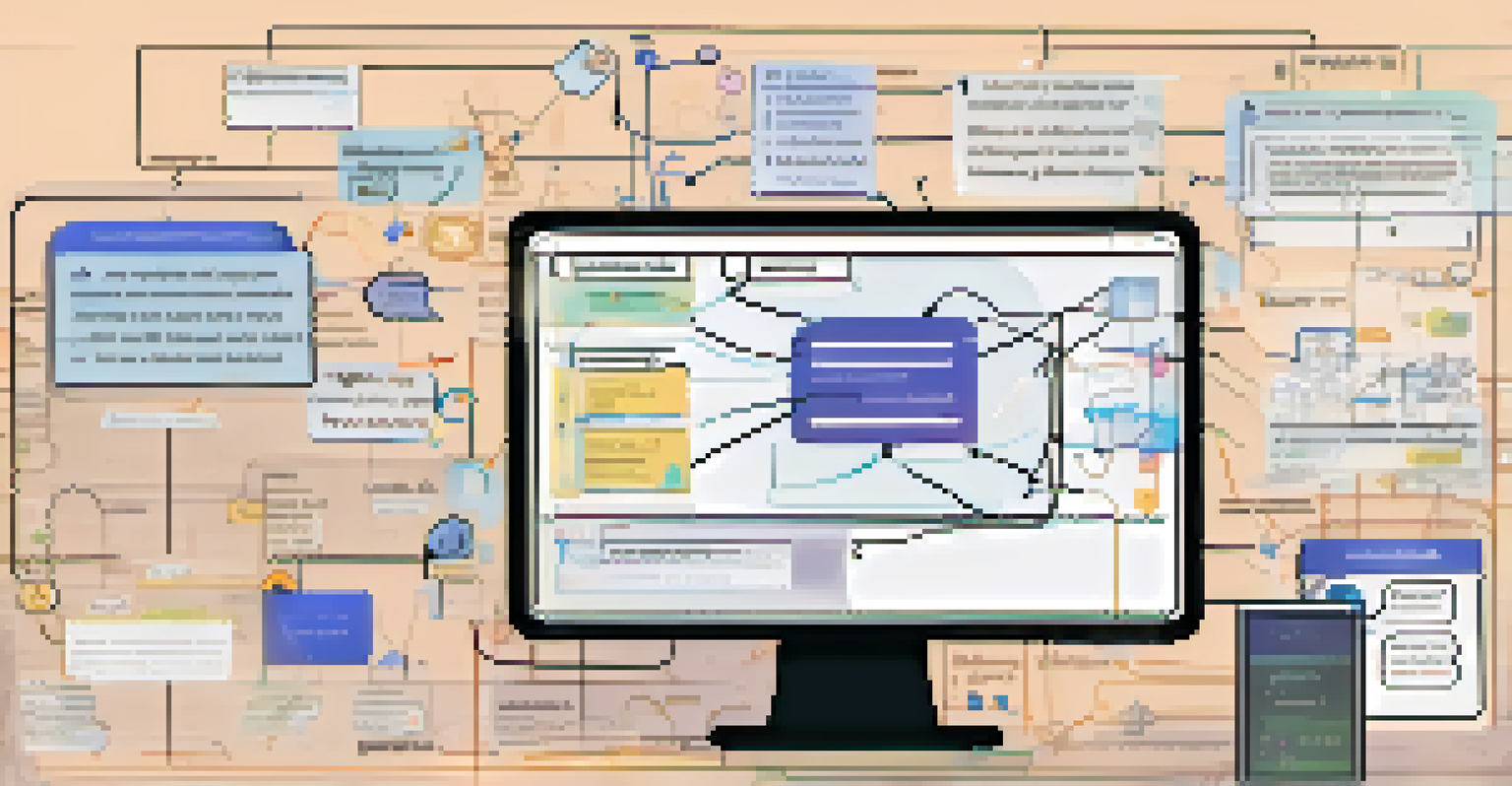Building a Chatbot with Natural Language Processing

Understanding Chatbots and Their Importance
Chatbots have become an integral part of our digital communication, offering users instant assistance and information. They can be found on websites, messaging apps, and even social media platforms, providing a seamless way to engage with customers. By automating responses to frequently asked questions, businesses can improve efficiency and enhance customer satisfaction.
The goal of AI is to enable machines to learn and adapt like humans, making life easier and more efficient.
The importance of chatbots lies in their ability to provide 24/7 support, allowing businesses to reach a wider audience without the need for constant human oversight. This means customers can get answers to their queries at any time, resulting in better user experience and higher retention rates. As technology evolves, chatbots are becoming more sophisticated, making them indispensable tools in customer service.
A powerful chatbot is one that understands and processes human language effectively, which leads us to the role of Natural Language Processing (NLP). NLP equips chatbots with the ability to understand context, intent, and even emotions, making interactions feel more natural and human-like. This sets the stage for building chatbots that not only respond accurately but also create meaningful conversations.
What is Natural Language Processing?
Natural Language Processing, or NLP, is a branch of artificial intelligence that focuses on the interaction between computers and humans through natural language. Essentially, it enables machines to understand, interpret, and respond to human language in a way that is both meaningful and relevant. Think of NLP as the translator that helps chatbots speak 'human' language.

NLP encompasses various techniques such as tokenization, sentiment analysis, and named entity recognition, which help break down and analyze text. For example, tokenization splits sentences into individual words, making it easier for the chatbot to understand the components of a query. This foundational understanding is crucial for the chatbot to deliver accurate responses.
Chatbots Enhance Customer Interaction
Chatbots provide instant assistance and 24/7 support, improving user experience and customer satisfaction.
One of the key challenges of NLP is dealing with the nuances and complexities of human language, such as slang, idioms, and regional dialects. A well-designed NLP system can adapt to these variations, ensuring that the chatbot remains effective across diverse user interactions. By harnessing NLP, we can create more intuitive and user-friendly chatbots.
Choosing the Right NLP Tools for Your Chatbot
When building a chatbot, selecting the right NLP tools is critical to its success. There are various frameworks and libraries available, each with its own strengths and weaknesses. Some popular options include Google’s Dialogflow, Microsoft’s Bot Framework, and open-source libraries like SpaCy and NLTK.
Chatbots are the bridge between people and technology, making our interactions with machines more human-like.
Each tool offers different features, such as ease of integration, pre-built models, and support for multiple languages. For instance, Dialogflow provides a user-friendly interface and strong integration capabilities with various platforms, making it a great choice for beginners. On the other hand, open-source libraries allow for more customization, albeit with a steeper learning curve.
Ultimately, the choice of tools should align with your chatbot's objectives and the technical expertise of your development team. Consider factors such as scalability, support, and community resources available for each option. By choosing the right tools, you set the foundation for a successful chatbot that meets user needs effectively.
Designing Conversational Flows and User Experience
Creating a chatbot isn’t just about coding; it’s also about designing a seamless conversational flow. This involves mapping out how users are likely to interact with the bot and anticipating their needs. A well-designed flow ensures that users can easily navigate the conversation and get the information they seek without frustration.
Start by identifying common questions and scenarios that users may encounter. This can be achieved through user research and analyzing existing customer interactions. Creating a flowchart can help visualize the conversation paths and ensure that the chatbot can handle various user intents effectively.
NLP Powers Chatbot Understanding
Natural Language Processing enables chatbots to understand human language, context, and emotions for more meaningful interactions.
In addition to flow, consider the tone and personality of your chatbot. Whether it’s friendly, formal, or quirky, the bot's voice should reflect your brand values. A relatable personality can enhance user engagement and make interactions feel more personal, ultimately leading to a better user experience.
Implementing Machine Learning in Your Chatbot
Machine learning can significantly enhance the capabilities of your chatbot by enabling it to learn from interactions and improve over time. Instead of relying solely on pre-defined responses, a machine learning model can analyze user data and adjust its responses based on patterns it identifies. This adaptability makes the chatbot smarter and more effective in handling diverse queries.
To implement machine learning, you’ll need to train your model using historical chat data, allowing it to recognize intents and learn appropriate responses. This process involves feeding the model examples of conversations, which helps it understand different ways users might ask the same question. The more data you provide, the better your chatbot can perform.
However, machine learning requires ongoing maintenance and monitoring to ensure accuracy and relevance. Regularly updating the model with new data and retraining it will keep your chatbot in tune with changing user preferences and language trends. By leveraging machine learning, your chatbot can evolve and provide an increasingly personalized experience.
Testing and Iterating Your Chatbot
Once your chatbot is built, the next crucial step is testing it rigorously to ensure it meets user expectations. This involves both functionality testing, where you check if everything works as intended, and user acceptance testing, where real users interact with the bot to provide feedback. The insights gained during this phase are invaluable for refining the chatbot's performance.
Pay attention to how well the chatbot understands user queries and how accurately it responds. Are there common misunderstandings or areas where users seem confused? Collecting user feedback can help pinpoint these issues and inform necessary adjustments to the conversational flow or responses.
Ongoing Testing Ensures Chatbot Success
Regular testing and iteration are crucial for refining chatbot performance and adapting to user feedback.
Iterative testing is key to continuous improvement. After making changes, conduct further testing to assess the impact of those adjustments. This cycle of testing and iterating ensures that your chatbot remains effective and relevant, ultimately leading to a better user experience.
Deploying Your Chatbot and Measuring Success
After all the hard work in building and refining your chatbot, it’s time to deploy it and let users interact with it. Choose the right platforms for deployment based on where your target audience is most active. This could be your website, social media channels, or even messaging apps. Ensuring easy access can significantly boost user engagement.
Once deployed, it’s important to measure the success of your chatbot. Key performance indicators (KPIs) to consider include user engagement rates, resolution times, and user satisfaction scores. These metrics will help you gauge how well your chatbot is performing and where there may be room for improvement.

Remember, the journey doesn’t end with deployment. Regularly review performance data and user feedback to continue enhancing your chatbot. By staying attentive to user needs and making data-driven adjustments, you can ensure that your chatbot remains a valuable asset for your business.